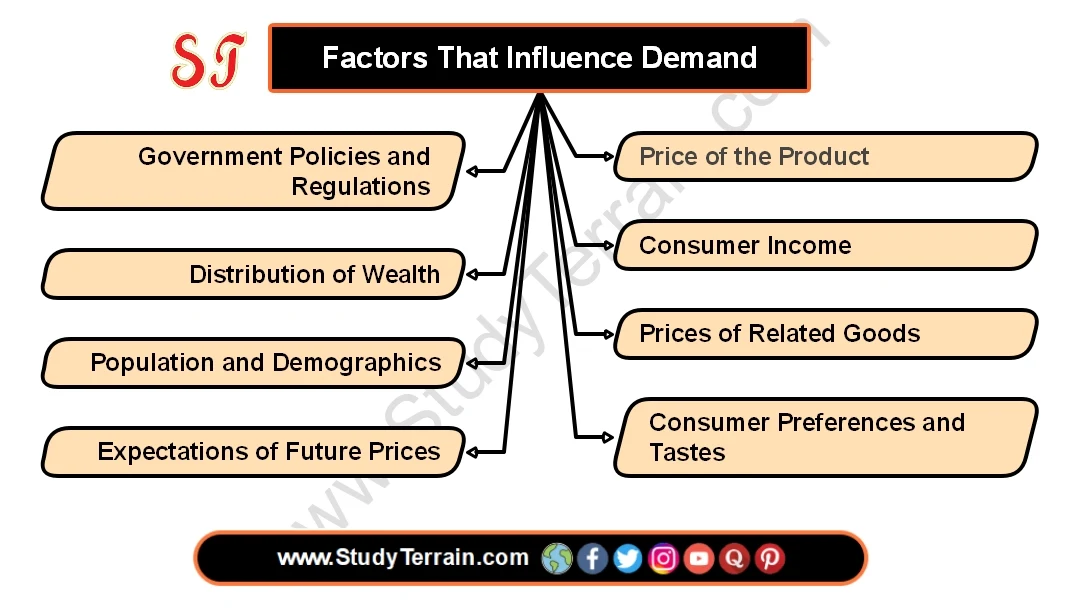In the realm of economics, understanding what drives consumer behavior is crucial for businesses, policymakers, and economists alike. The determinants of demand play a pivotal role in shaping how much of a good or service consumers are willing and able to buy at various price levels. We'll delve into the various factors that influence demand and explore their significance in economic analysis.
Table of content (toc)
Factors That Influence Demand
 |
| Factors That Influence Demand |
Price of the Product
The price of a product is perhaps the most obvious determinant of demand. According to the law of demand, as the price of a good or service increases, the quantity demanded decreases, and vice versa. This inverse relationship between price and quantity demanded is represented by a downward-sloping demand curve. Businesses often conduct price elasticity studies to understand how changes in price affect consumer demand and revenue.
Consumer Income
Consumer income is another significant determinant of demand. For most goods, as consumers' income increases, their demand for those goods also increases. However, this relationship is not uniform across all types of goods:
Normal Goods
For normal goods, demand increases with income. Examples include luxury items, vacations, and higher-quality food products.
Inferior Goods
Inferior goods are those for which demand decreases as income increases. These goods are often replaced with better alternatives as consumers' income rises. Examples include generic brands, public transportation, and used goods.
Understanding the income elasticity of demand helps businesses tailor their products and marketing strategies to different income segments of the market.
Prices of Related Goods
The prices of related goods also influence consumer demand. There are two main categories of related goods:
Substitute Goods
Substitute goods are products that can be used as alternatives to each other. When the price of one substitute increases, the demand for the other substitute increases. For example, if the price of beef rises, consumers may switch to chicken instead.
Complementary Goods
Complementary goods are products that are used together. When the price of one complement increases, the demand for the other complement decreases. For instance, if the price of printers decreases, the demand for printer ink cartridges may increase.
Consumer Preferences and Tastes
Consumer preferences and tastes play a significant role in determining demand. Factors such as cultural influences, advertising, fashion trends, and changes in lifestyle can all affect consumer preferences. For example, increased health awareness may lead to greater demand for organic foods and fitness-related products.
Expectations of Future Prices
Consumer expectations about future prices can also influence current demand. If consumers expect prices to rise in the future, they may increase their demand now to avoid paying higher prices later. Conversely, if they expect prices to fall, they may postpone purchases, leading to a decrease in current demand.
Population and Demographics
Population size and demographics also impact demand. Changes in population size, age distribution, and income levels can affect demand for various goods and services. For example, an aging population may lead to increased demand for healthcare services and retirement products.
Distribution of Wealth
The distribution of wealth in society can also influence demand. When wealth is concentrated in the hands of a small portion of the population, overall demand may be limited. Conversely, a more equitable distribution of wealth may lead to higher demand as more people have purchasing power.
Government Policies and Regulations
Government policies and regulations can have a significant impact on demand. For instance, taxation policies, subsidies, and trade restrictions can affect the prices of goods and services, thereby influencing consumer demand. Additionally, regulations related to health, safety, and environmental standards can shape consumer preferences and demand for certain products.
Conclusion
The determinants of demand are diverse and multifaceted, reflecting the complex interplay of economic, social, and political factors that influence consumer behavior. By understanding these determinants, businesses can make informed decisions about pricing, production, and marketing strategies. Policymakers can also use this knowledge to design effective policies that promote economic growth and stability. Ultimately, a comprehensive understanding of the determinants of demand is essential for navigating the ever-changing marketplace and meeting the needs of consumers in an efficient and effective manner.
For more content visit Managerial Economics



